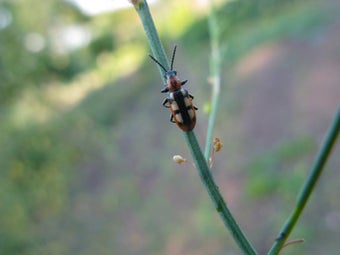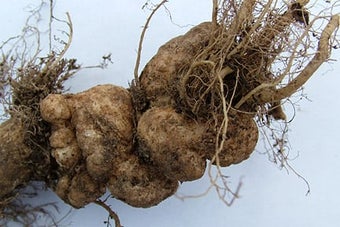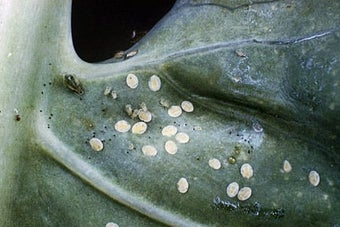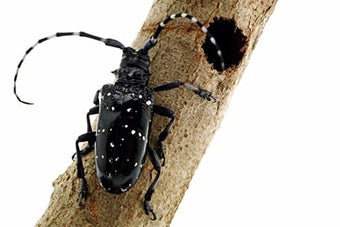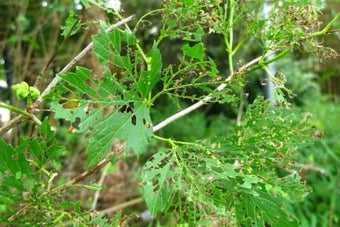
Quick facts
Common name - Flea beetle
Scientific name - Various, mainly Phyllotreta and Psylliodes species on brassicas and allied plants
Plants affected - Many plants in the brassica family, including cabbage, broccoli, sprouts, turnip, radish, salad rocket, wallflower and alyssum. Also nasturtium and Cleome
Main symptoms - Small rounded holes in the foliage, especially on seedlings. Small beetles jump off plants when disturbed
Most active - Spring and summer
What are flea beetles?
There are more than 100 species of flea beetle in Britain, they are a subfamily of the leaf beetles (Chrysomelidae). Most do not feed on garden plants or have a noticeable effect on them, a few species in the genera Phyllotreta and Psylliodes feed on brassicas and related plants. The small beetles are 2-3 mm (about 1/10 in) long, with enlarged hind-legs that enable them to leap when disturbed. The adults feed on the leaves and the larvae on the roots, the root damage does not usually affect crops in gardens.
Symptoms
- Rounded holes are scalloped out of the upper leaf surface; often these do not go all the way through the leaf. The damaged areas dry up and turn pale brown
- Seedling plants are particularly susceptible, the growth of older plants is only checked if populations are large
- Several Phyllotreta and Psylliodes species can be responsible. These beetles are 2-3 mm (about 1/10 in) long, coloured black or metallic green or blue, some have a yellow stripe running the length of each wing case
- Adult flea beetles can be seen jumping off leaves when disturbed
- Root feeding by the grubs does not usually affect growth in home gardens
Management
Populations of this beetle can be tolerated, especially on larger brassicas where outer leaves are discarded. These beetles usually have a limited effect on edible parts.
- Encourage wildlife in the garden, such as birds, frogs and predatory ground beetles who will eat the larvae and sometimes the adult beetles
- Growing susceptible crops under insect proof mesh may keep the beetles out
Biology
- Brassica flea beetles overwinter in leaf litter as adult beetles that emerge in mid-spring to feed on of brassicas and other host plants
- In late summer there is sometimes a significant migration of adult beetles into gardens from brassica crops especially oilseed rape fields, when damage to mature plants can occur
- The whitish brown larvae live in the soil and feed on the plants' roots, but this does not usually cause significant damage in gardens
- Pupation takes place in the soil in mid-summer



